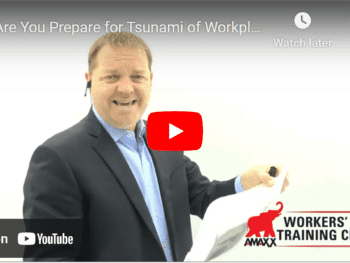Hey, there. Michael Stack here, CEO of AMAX. So very big national news over the past weekend with the confirmation of Brett Kavanaugh as the latest Supreme Court justice of the United States.
Now, this was obviously a very politically charged and bitter process. And whether you are in complete support of Mr. Kavanaugh or complete opposition, it’s not for me to tell you whether you were right or wrong, that’s up for you to decide. But there was one thing out of this process that struck me that I think we can all learn and apply to our work comp program and it’s the importance of this line here right in the middle.
Kavanaugh Process Had Hard Line of Separation
In the Kavanaugh process, this line was very clearly defined. You were either in support or you were in opposition. Now, there are some lessons in politics that we can use as examples to follow and there are some lessons that we can use as warnings, so let’s talk about this process now.
Don’t take this left and right now as having anything to do with politics because it doesn’t. Now in worker’s compensation, there’s really somewhat two schools of thought. There’s the advocacy model, a claims advocacy model, and more of a litigation type of model. Now on this advocacy side, you’re looking out for the employee’s best interest. You’re working together as a team. You’re looking to give them the best medical support. You’re establishing trust, you’re communicating, you’re sending a get well card. You’re going to visit them at the hospital and you’re trying to get them back to work in a timely fashion, working together as a team to lower your costs and improve those outcomes.
Now, some in opposition to that will say, “Well, that’s kind of maybe a little bit soft,” that you’re just skipping through the flower fields, hoping that everything is right and you’re just kind of la, la, la going around and everyone’s great and we’re just going to look out for everyone’s best interest and it’s all gonna work out.
So that opposition model will hold the mindset often of this litigation mindset and say, “Well, no one’s going to pull one over on me. If my employees are committing fraud, I’m going to crush them and I’m going to deny their claim,” etc. etc. etc. And on that goes.
Politics Has Positive Examples and Warnings
Here’s the lesson that we need to learn from this process and we’re looking at this hard line of both of the positive examples and the warnings is that in worker’s compensation, these are actually the same thing and should be the same thing and they should all be working together all at the same time. So here’s what I mean by that.
Is that yes, there’s a very hard line in the middle and this needs to be very clearly defined in your program just like it was in the Kavanaugh process, but at the same time, this litigation mindset also needs to be over here and here’s what I mean by that, is you start with the advocacy model. You start by looking out for your employees’ best interest. You start by setting expectations. You start by establishing trust. You start by giving them the best medical, getting them back to work, providing a transitional duty job that’s going to create a better outcome and lower your costs, but at the same time you’re also doing a thorough investigation.
Claims Advocacy & Litigation Work Together in Tandem
You’re establishing what actually happened in that claim. You’re establishing good information in order to make a good decision on what is actually happening and you’re setting an expectation for your employees as well that they need to come to the table. We’re going to give you all the support we can, but we also have an expectation for you to participate in the process and when you do have this line very clearly defined in the middle and when your employee is trying to pull one over you with a fraudulent claim, they’re malingering. They’re trying to get extra medical treatments included when they shouldn’t be.
You have that very clearly hard line defined and you’ve already done the work at the beginning of the claim to establish your position and so then you can deny that claim appropriately with a very strong and very powerful litigation aspect of your claim as well. Both of those philosophies need to be working together in tandem and only when your employee passes that hard line in the middle is when you deploy that litigation mindset.
Again, I’m Michael Stack, CEO of AMAX, and remember your work today in workers’ compensation can have a dramatic impact on your company’s bottom line, but it will have a dramatic impact on someone’s life. So, be great.

Contact: mstack@reduceyourworkerscomp.com.
Workers’ Comp Roundup Blog: https://blog.reduceyourworkerscomp.com/
©2018 Amaxx LLC. All rights reserved under International Copyright Law.
Do not use this information without independent verification. All state laws vary. You should consult with your insurance broker, attorney, or qualified professional.










